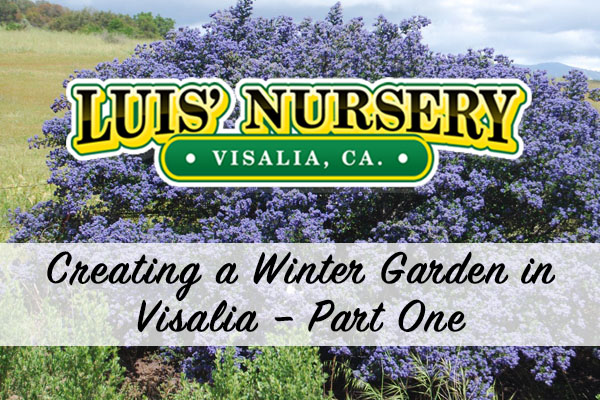The San Joaquin Valley and Visalia area are known for milder winters than much of the rest of the United States. This lends itself to a more enjoyable gardening season than other areas and is the time to think about a winter garden. Our cool, wet weather marks the beginning of the growing season for California native and Mediterranean climate plants.
Our winter brings life to summer drought adapted plants and the start of root growth. You’ll often see once dormant plants leafing out and bursting into bloom. Imagine walking through your garden on a gray winter day with low lying fog. This is a beautiful time to take note of ornamental tree bark, plant forms and foliage, and clusters of glossy berries that may be overlooked during our summers. These plants are overshadowed in the summer by the pollinators and masses of flowers, and now it’s their time to shine. Migrating birds often take a moment or two to enjoy your winter garden and send their beautiful calls into the grey winter air. How do bring this imagery to life and create a winter garden that you can enjoy?
What to plant to create your winter garden
Shrubs and trees are the ‘bones’ of your winter garden. These plants provide the foundations and backdrop for smaller plants that will come and grow throughout the winter season.
Some examples of evergreen shrubs to use are:
- Sugar Bush – great for structure
- California wild lilac – great for structure
- Toyon – great for structure
- Lemonade Berry – great for structure
- Silk Tassel Bush – long silvery dangling flower clusters great for a feature piece
If you have lower light conditions, you can really take advantage of some ornamental barks. Bark can provide color that is sometimes subtle and sometimes bright and add an artistic structural emphasis to your garden in the winter.
Some examples of bark to use are:
- Evergreen madrone – mahogany-colored peeling bark on muscular trunks
- Manzanitas – mahogany-colored peeling bark on muscular trunks
- Fern-leaf Catalina ironwood – Shiny, divided leaves and reddish, shredding bark provides rare interest
- California buckeye – nearly white branches look like a reverse lightning bolt and add to the artistic imagery
If you’re looking to create some winter bloom and add some color to the dreary months you can add various plants that do well in the winter.
Some examples of winter blooms are:
- California currants – great for the coldest months.
- Foothill currant – Flowers from November to January and provides hummingbird nectar for late season birds
- Golden currant – Best for later in the season and creates beautiful flowers
- Evergreen currant – Shiny mounds of foliage beneath majestic oaks with tiny flowers that when in full bloom create a maroon mist.
- Manzanitas – In January and February these produce urn-shaped flowers in clusters that provide an artistic display of pale pink flowers with a dark-green foliage backdrop.
- Azure Bush Germander – Provides a dramatic bloom of deep blue flowers among silvery white foliage.
As you start to create your winter garden you will find that the Visalia area lends itself to the joy of gardening year-round. There are a few adjustments that need to be made each season and a general maintenance list that will help you along the way.
In our next article we will discuss a few more features you can add to your winter garden as well as some basic maintenance tips. As always, we look forward to seeing you at the nursery, and we’re eager to help you answer any questions regarding your gardening needs!

